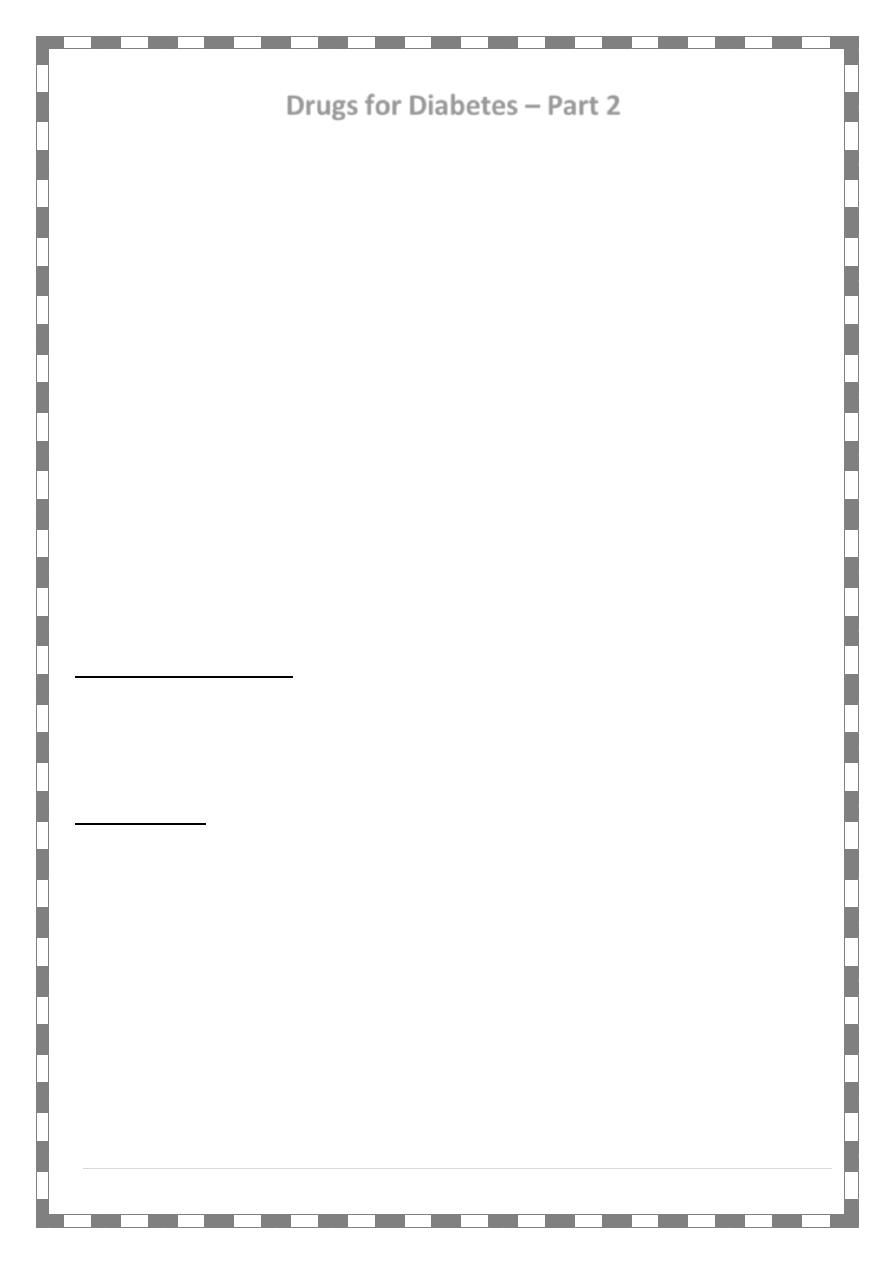
Third Stage
Pharmacology
Dr. Aqeel K.
P a g e
| 1
|
Drugs for Diabetes – Part 2
Oral agents
Oral agents are useful in the Rx of patient have type 2 DM that is not cotrolled by diet
and exercise.
Sulfonylureas
They are insulin secretagogues
Chlorpropamide
Glibenclamide
Glyburide
Glipizide
Glimepiride
Gliclazide
Stimulation of insulin release from the B-cells of pancreas
Sulfonylureas block ATP=sensitive K
+
channels, resulting in depolarization Ca
+2
influx and
insulin exocytosis. In addition, sulfonylureas may reduce hepatic glucose production and
increase peripheral insulin sensitivity.
Pharmacokinetic and fate
They bind to serum protein, metabolized by the liver, and excreted in the urine and
feces.
Duration of action from 12 to 24 hours.
Adverse effects
Weight gain
Hyperinsulinemia
Hypoglycemia
Used with caution in hepatic or renal insufficiency
In renal impaired the problem is mainly in glyburide as it may increase the duration of
action and increase the risk of hypoglycemia
Glipizide or glimepiride are safer option in renal dysfunction and in elderly patients.
Glyburide has minimal transfer across the placenta and may be alternative t insulin for
DM in pregnancy.

Third Stage
Pharmacology
Dr. Aqeel K.
P a g e
| 2
|
Glinides
This class of agent include
Repaglinide
Nateglinide
They are also considered insulin secretagogues.
Mechanism of action
The glinide stimulate insulin secretion.
They bind to a distinct site on the B-cell closing ATP sensitive K
+
channel and initiating a
series of reactions that results in the release of insulin.
They have rapid onset and short duration of action.
They are post-prandial glucose regulators.
Pharmacokinetic and fate
Taken prior to meal
Metabolized to inactive products by cytochrome P4503A4 in the liver and excreted
through the bile.
Adverse effects
Hypoglycemia
Weight gain
Biguanides
Metformin, the only biguanide is classified as an insulin sensitizer.
It increases glucose uptake and use by target tissues, thereby decrease insulin
resistance.
It does not promote insulin secretion. So that there is no risk of hypoglycemia.
Mechanism of action
Main mechanism is:
1- Reduce of hepatic gluconeogenesis.
2- Slow intestinal absorption of glucose.
3- Improve peripheral glucose uptake and utilization.
Less than sulfonylureas

Third Stage
Pharmacology
Dr. Aqeel K.
P a g e
| 3
|
4- It can be used alone or in combined with other oral agents or insulin.
Pharmacokinetics and fate
Well absorbed orally, not bind to serum protein, not metabolized. Excretion is via the
urine.
Adverse effects
1- Nausea
2- Contraindicated in renal dysfunction due to the risk of lactic acidosis.
3- Discontinued in case of acute MI.
4- Discontinued in exacerbation of HF
5- Discontinued in sepsis.
6- Discontinued in hepatic failure.
7- Used cautiously in older than 80 years and alcohol abuse.
In case of procedure require IV radiographic contrast, stop metformin 48 hours before
the procedure and for 5 days after.
Long-term use may interfere with vitamin B12.
Other uses
It is used in the Rx of polycystic ovary syndrome.
Also can be used in Rx of obesity.
Thiazolidinediones (TZD)
They are insulin sensitizers.
They are:
Pioglitazone
Rosiglitazone
Mechanism of action
TZD lower insulin resistance.
Increase insulin sensitivity in adipose tissue, liver and skeletal muscles.
Rosiglitazone increase LDL, TG, HDL
Pioglitazone Decrease TG, Increase HDL.

Third Stage
Pharmacology
Dr. Aqeel K.
P a g e
| 4
|
Pharmacokinetics and fate
TZD: well absorbed after oral administration then extensively bound to serum albumin.
They undergo extensive metabolism by different CYP450 isoenzymes.
Pioglitazone & its metabolite excreted in the bile and eliminated in the feces.
Rosiglitazone excreted mainly in the urine.
No dosage adjustment is required in renal impairment.
These agents should be avoided in the lactating mother.
Adverse effects
Few cases of liver toxicity have been reported.
Weight gain.
Fluid retention.
Osteopenia and increase fracture risk.
Pioglitazone may also increase risk of bladder cancer.
Increase MI risk in rosiglitazone.
Other uses can be used in women with polycystic ovary syndrome.
-Glucosidase inhibitors
Acarbose
Miglitol
Mechanism of action
They inhibit -glucosidase enzymes when taken at the start of meal.
Pharmacokinetic and fate
Acarbose is poorly absorbed, it is metabolized primarily by intestine bacteria and some
of the metabolites are absorbed and excreted into the urine.
Miglitol is very well absorbed but has no systemic effect. It is excreted unchanged by the
kidney.
Adverse effects
Flatulence
Diarrhea
Abdominal cramping.

Third Stage
Pharmacology
Dr. Aqeel K.
P a g e
| 5
|
Dipeptidyl Peptidase -4inhibitor (DPP-4 inhibitors)
Sitagliptin
Alogliptin
Linagliptin
Saxagliptin
Vildagliptin
Mechanism of action
These drugs inhibit enzyme DPPD-4 which is responsible for the inactivation of incretin
hormones such as GLP-1.
Prolongation of the activity of incretin hormones
Increase insulin release in response to meal and Decrease inappropriate secretion
of glucagon.
Unlike incretin mimetic, these drugs do not cause satiety or fullness and are weight
neutral.
Pharmacokinetics and fate
DPP-4 inhibitors are well absorbed after oral administration.
Food does not affect the extent of absorption.
Alogliptin and sitagliptin are mostly excreted unchanged in the urine.
Saxagliptin is metabolized via CYP4503A4/5 to an active metabolite. The rout of
excretion of saxagliptin and its metabolite is renal.
Linagliptin is primarily eliminated via the enterohepatic system.
All DPP-4 inhibitors except Linagliptin require dosage adjustment in renal dysfunction.
Adverse effects
Nasopharyngitis
Headache
Rare pancreatitis.
Sodium-glucose cotransporter 2 inhibitor (SGT2-inhibitor)
Canagliflozin
Dapagliflozin

Third Stage
Pharmacology
Dr. Aqeel K.
P a g e
| 6
|
Mechanism of action
SGLT2 is responsible for reabsorbing filtered glucose in the tubular lumen of the kidney.
By inhibiting SGLT2 these agent decrease reabsorption of glucose and increase urinary
glucose excretion and lower blood glucose.
Inhibitor of SGLT2 also decrease reabsorption of NA and cause osmotic diuretic.
Therefore, SGLT2 inhibitor may reduce systolic blood pressure.
Pharmacokinetic and fate
Given once daily in the morning
Both drugs are mainly metabolized by glucuronidation to inactive metabolites.
Excretion mainly via the feces.
These agents should be avoided in patients with renal dysfunction.
Adverse effects
Female genital mycotic infection
UTI
Urinary frequency
Hypotension
and,
Thank You,,,
